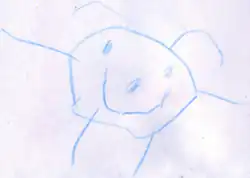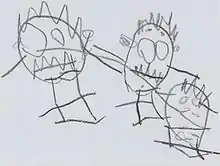Headfooters
Headfooters or tadpole people are simplistic representations of human beings as a figure without a torso, with arms and legs attached to the head. They appear in the drawings of young children before they learn to draw torsos and move on to more realistic figures such as stick figures.

Preschoolers who draw headfooters will generally not draw torsos, even when instructed to include features that are part of the torso, such as a belly button. Instead, they tend to draw the feature onto the headfooter without modifying the figure.[1][2]
Clinical significance

In cognitive tests such as the Draw-a-Person test, the drawing of headfooters by adults may indicate a cognitive impairment. For example, demented patients tend to draw headfooters when tasked to draw human figures.[3]
In art

The early work of Austrian artist Oswald Tschirtner often contained Headfooters.[4][5]
The Last Judgment by Hieronymus Bosch features a grylloi that shares features with headfooters.
References
- Coté, Carol A.; Golbeck, Susan (2007-08-13). "Pre‐schoolers' feature placement on own and others' person drawings". International Journal of Early Years Education. 15 (3): 231–243. doi:10.1080/09669760701516868. Retrieved 2023-03-20.
- Boyatzis, C.J.; Michaelson, P.; Lyle, E. (1995). "Symbolic immunity and flexibility in preschoolers' human figure drawings". The Journal of Genetic Psychology. 156 (3): 293–302. doi:10.1080/00221325.1995.9914824. Retrieved 2023-03-20.
- Ericsson, Kjerstin; Hillerås, Pernilla; Holmen, Karin; Winblad, Bengt (1996). "Human-figure drawing (HFD) in the screening of cognitive impairment in old age". Journal of Medical Screening. 3 (2): 105–109. doi:10.1177/096914139600300212. Retrieved 2023-03-20.
- "Oswald Tschirtner". Raw Vision. No. 2. 1989. p. 32.
- Maizels, John (2000-09-20). Raw Creation: Outsider Art and Beyond. Phaidon Press. p. 90. ISBN 978-0714840093.